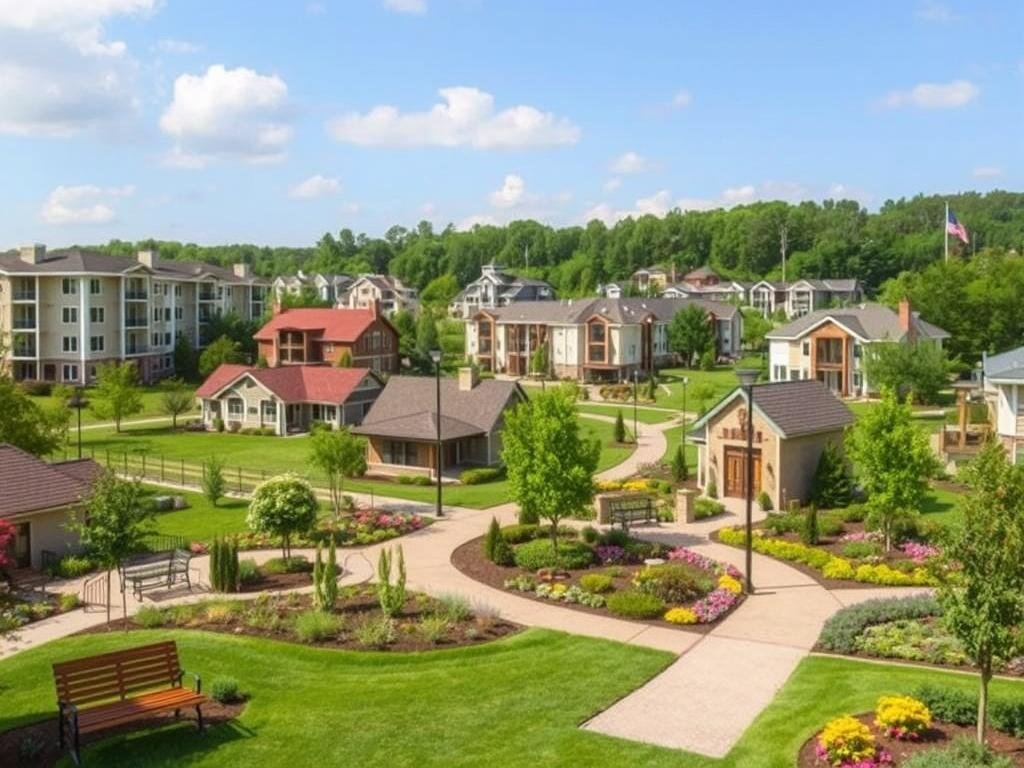Did you know that only 41 percent of Americans would use their savings for big, unplanned expenses? This fact is worrying, especially for seniors facing rising housing costs because of inflation. Since September 2024, 62 percent of people in the US feel their emergency savings are not enough. This has grown over the years. The high cost of living is making it harder to afford senior housing. This is because the cost for upkeep, taxes, and utilities is going up.
The increase in living costs is not just a short-term problem. It is a bigger economic issue. Now, 73 percent of Americans are saving less for emergencies. For those living on a fixed income, this situation makes finding affordable housing very hard. If you are a senior or helping someone plan for the future, knowing how inflation changes housing costs is important. This knowledge helps handle the challenges and make wise choices.
Key Takeaways
- Inflation is driving up the cost of senior housing, affecting affordability.
- Only 41 percent of Americans would use savings for major unexpected expenses, impacting financial security for seniors.
- 62 percent of Americans feel behind in their emergency savings, with senior housing costs escalating as a result.
- 73 percent of Americans report saving less for emergencies due to inflation and other economic factors.
- Understanding how inflation affects senior housing can help you make informed decisions.
Understanding Inflation and Its Current Trends
Inflation understanding is key, especially for those living on fixed incomes. Knowing about inflation helps manage living costs and adjust to the economy. This is very important for seniors.
What is Inflation?
Inflation is how prices for stuff we buy go up, making our money worth less. Simply put, things will cost more tomorrow than they do today. It affects everything, including the cost of where seniors live.
Recent Trends in Inflation Rates
Recent data shows changes in inflation. For example, the Leading Economic Index (LEI) went down slightly in December 2024 but had gone up in November. The LEI dropped in both halves of 2024. Yet, the economy still grew.
Experts predict the U.S. economy will grow by 2.3 percent in 2025. The International Monetary Fund (IMF) thinks it might even reach 2.7 percent. Luckily, the annual inflation rate fell to 2.9 percent by the end of 2024. This makes some costs more predictable for seniors.
Why It Matters for Seniors
Sit is crucial for seniors to know how inflation impacts housing costs. With inflation goals at 2 percent, the forecast is stable yet cautious. Inflation makes everything more expensive, including housing.
This means seniors need to watch how housing costs like taxes and bills are rising. These increases directly impact how affordable a home is.
| Year | GDP Growth (%) | Annual Inflation Rate (%) |
|---|---|---|
| 2024 | 1.6 – 3.1 | 2.9 |
| 2025 | 2.3 – 2.7 (Projected) | 2.0 (Target) |
Keeping up with inflation trends is part of managing senior living costs. By understanding the economy, you can make smarter plans for now and later.
How Inflation Affects Senior Housing Costs
Inflation is making senior housing more expensive. Rising prices affect everything from property management to maintenance. This makes it tougher for seniors to afford their homes.
Increased Maintenance and Operation Costs
Inflation means higher costs for maintenance and operations. The cost of labor and materials is going up. This leads to more expensive repairs and upkeep, making seniors pay more for housing.

Reports show more orders for manufacturing and more building permits. This demand increases the cost of materials and services. It makes it hard to keep senior housing costs down.
Rising Property Taxes and Utility Bills
Property taxes and utility bills are also getting higher with inflation. This hits seniors hard, especially those on fixed incomes. It’s tough for them to handle these growing costs.
Energy prices and other services are rising too. These costs are increasing the financial pressure on seniors. They already struggle with housing costs and are looking for ways to manage their expenses.
Increases in maintenance costs can make property values go up. This then leads to higher taxes. All these costs together make securing affordable housing challenging for seniors.
Summary of Core Impacts
| Impact Area | Influence |
|---|---|
| Maintenance and Operations | Higher labor and material costs |
| Property Taxes | Increased due to rising property values |
| Utility Bills | Higher energy and service costs |
It’s very important to understand how inflation affects senior housing. If you are planning for retirement or manage senior living communities, this knowledge will help. Knowing about these pressures can help you make better choices to manage and reduce housing costs for seniors.
The Impact on Assisted Living Communities
Inflation is making it harder to keep senior housing affordable in assisted living communities. Costs are going up, and it’s tough for facilities to keep their services great without charging more. We’ll look into how this affects the people working there and the services provided.

Staffing and Wage Increases
One big trend in senior housing costs is the need to pay workers more. To keep good staff, the pay must rise to match inflation. This is tough for assisted living places, as they need to spend more. Often, they have to charge residents more to cover these costs.
“With the inflation impact on senior housing costs, we also face increased competition for skilled caregivers,” says industry expert Sarah Harris. “It’s imperative to pay competitive wages to attract and retain the best talent, which ultimately benefits our residents.”
Changes in Service Availability
To deal with higher costs, some assisted living places might cut back on some services. Things that aren’t essential might cost extra or not be offered. Also, keeping up with high service standards becomes harder, which might mean less staff for each resident or fewer activities.
This situation shows how hard it is for senior housing to manage rising costs. They need creative ways to save money without lowering the quality of care.
Financing Senior Housing Amid Inflation
Inflation impacts senior housing costs a lot. As prices go up, finding different ways to pay for these costs is key. This part looks at how mortgage rates create challenges and checks out other ways to pay.
Mortgage Rates and Senior Housing
Getting a mortgage for senior housing is tougher with inflation. The Conference Board’s Leading Economic Index (LEI) says economic shifts affect mortgage rates a lot. By the first half of 2024, the LEI went down by 1.7 percent and 1.3 percent in the second, showing uncertain economic times.
With the GDP expected to grow by 2.3 percent in 2025, staying updated on mortgage rates is crucial for seniors. The U.S. economy’s growth was uneven in 2024, with rates of 1.6 percent, 3.0 percent, and 3.1 percent across quarters. These changes stress the importance of careful money planning and finding good mortgage rates for affordable senior housing.
Alternative Financing Options
When mortgage rates are too high, there are other ways for seniors to manage housing costs. Looking into reverse mortgages and sharing a house are two good options. These choices can help lessen the financial strain from inflation, no matter the economy.
Reverse mortgages are popular because they let seniors turn some of their home equity into cash without selling their house. Shared housing cuts down on expenses by sharing costs. Both choices can really help with the climbing costs of senior housing. With a 2.7 percent GDP growth expected in 2024 by the International Monetary Fund (IMF), these options can provide financial stability during economic changes.
This table shows the pros and cons of reverse mortgages and shared housing:
| Financing Option | Benefits | Considerations |
|---|---|---|
| Reverse Mortgages | Provides additional income | May affect inheritance |
| Shared Housing | Reduces living expenses | Requires compatibility with cohabitants |
Using these strategies is great for managing senior housing costs. With a 2.0 percent economic growth rate expected in 2025 by the National Association for Business Economics (NABE), being ahead and using these payment options is wise. This way, seniors can protect themselves financially from inflation’s impact.
Government Programs and Assistance
With the rise in senior housing costs, many seniors and their families are seeking government help. This assistance can help lessen the financial strain. Finding and using these resources can help manage the costs of senior living better.

Medicaid and Medicare Support
Medicaid and Medicare are key in supporting seniors, especially with healthcare costs. Medicaid is vital for seniors with low income needing long-term care. This includes care in nursing homes and assisted living. Many states have Medicaid waivers allowing seniors to get care at home rather than in bigger facilities. Medicare mainly covers medical costs but sometimes helps with home health services too.
Local Housing Assistance Programs
Local programs are also crucial for helping seniors. They offer financial aid, subsidies, or vouchers for rent or property taxes. Due to rising housing costs for seniors, local programs are adapting. Seniors should talk to local agencies to learn about available help and how to apply.
| Program | Description | Eligibility Criteria |
|---|---|---|
| Medicaid | Medical and long-term care support | Low-income seniors |
| Medicare | Health insurance coverage | Individuals 65+ or with certain disabilities |
| HCBS Waivers | In-home care support | Varies by state |
| Local Subsidies | Financial aid for housing costs | Income and age-specific |
Looking into these options can ease the pressure from housing cost increases. This means seniors can have a more stable and cost-effective place to live.
Planning for Retirement Housing Costs
When planning for retirement, think about the cost of living for seniors. Remember to include the effect of rising prices over time. It’s important to budget and save well to handle expenses in the future.
Budgeting for Increased Expenses
Costs like property taxes and utility bills are likely to go up. Since mortgage rates change and home prices rise, plan ahead. To help the housing market, rates might need to fall to about 5.5%.
Knowing how these factors affect senior housing costs is key. To handle your expenses well, try the following:
- Keep track of your housing costs, including mortgage, taxes, and utilities.
- Plan for possible cost increases due to inflation and other changes.
- Adjust your budget to focus on needs and find ways to save money.
Saving Strategies for Seniors
Smart saving tips are important for managing costs in retirement. Here are some ways to make your money last longer:
- Maximize Retirement Savings: Put as much as you can into your retirement accounts. Starting early and getting employer match can really help.
- Downsize: Moving to a smaller, cheaper home can save money and reduce bills.
- Utilize Government Programs: Look into Medicaid, Medicare, and housing help to lower health and living costs.
- Investment Diversification: Spread your investments to manage risk and maybe earn more. Think about safe investments like bonds and savings accounts.

To handle senior housing costs well, plan carefully and save. By doing so, you’ll protect your money and have a worry-free retirement.
Evaluating Different Senior Housing Options
Choosing the right senior housing option is crucial in today’s economy. Understanding the benefits and drawbacks of each option aligns your choice with both personal needs and financial limits. The rising costs due to inflation significantly affect your decision.

Independent Living vs. Assisted Living
Independent living supports seniors who need little help. It offers freedom along with social and housekeeping amenities. These options are generally more budget-friendly than assisted living. But remember, inflation can raise the cost of these services over time.
Assisted living, however, offers extensive care like medication management and personal help. This is best for those needing daily assistance. The higher cost comes from these added services, and inflation can increase operational expenses, affecting what you pay for staff and upkeep. See the table below for a quick comparison:
| Feature | Independent Living | Assisted Living |
|---|---|---|
| Cost | Lower, with fewer services | Higher, due to extensive care |
| Amenities | Basic, social activities included | Comprehensive, including medical care |
| Ideal For | Active seniors with minimal care needs | Seniors needing daily assistance or medical care |
| Inflation Impact | Moderate, mainly on amenities | High, due to rising operational costs |
Continuing Care Retirement Communities (CCRCs)
CCRCs offer care at all levels, from independent to skilled nursing, in one place. They provide care for life, making it easier to move to different care levels as needed. While CCRCs need a big investment at first, they can be cost-effective long-term by addressing inflation.
CCRCs aim to protect your finances from rising care costs due to inflation. Paying more upfront means future expenses are more predictable. This makes evaluating CCRCs crucial for long-term financial health.
The Role of Location in Housing Costs
Looking into senior housing options? It’s key to know how location plays a part. Where you live greatly impacts how much you pay, especially with the regional differences in senior housing costs and the inflation impact on senior housing costs. We’ll explore how living in the city compares to the countryside and see how costs vary across the U.S.
Urban vs. Rural Senior Housing
Living in the city usually costs more. This is because a lot of people want to live there but there’s not much space. Seniors in big cities will see higher prices for buying or renting homes, plus paying more for upkeep. On the other hand, the countryside is often cheaper. However, it may lack some conveniences and medical services found in bigger cities. Choosing between city and countryside depends on what’s more important to you.
Regional Cost Variations
The regional differences in senior housing costs in the U.S. are big. For example, a place in New York City will cost a lot more than one in a small Midwest town. This difference is because of things like how much properties cost, the going rate for wages, and what services are around.
Also, the inflation impact on senior housing costs changes depending on where you are. With inflation, costs go up all over the country. But, areas that were already expensive get even pricier. Meanwhile, cheaper regions see smaller increases. Knowing this helps with planning where to live and managing your money in the future.
| Region | Average Monthly Cost (Urban) | Average Monthly Cost (Rural) |
|---|---|---|
| Northeast | $5,000 | $3,500 |
| Midwest | $4,200 | $3,000 |
| South | $4,500 | $3,200 |
| West | $5,200 | $4,000 |
Navigating Lease Agreements
It’s vital to know your lease agreement to manage senior living costs better. By learning about specific parts and how to talk about your lease, you can keep costs down, even with rising prices.
Understanding Rent Increases
Rent hikes are a big worry for seniors wanting to keep living costs affordable. Knowing the parts of your lease that talk about rent increases is key. This knowledge helps you get ready for any money changes.
Rent can go up with inflation, so watching inflation trends is critical.
Lease Negotiation Tips
Talking about your lease terms can help maintain your housing costs. Here are strategies for negotiating your lease:
- Research Comparable Prices: Compare prices of similar homes nearby to know what’s fair. This info helps when you talk to your landlord.
- Request a Cap on Rent Increases: Ask for a limit on how much your rent can go up each year. This protects you from big, unexpected rises.
- Highlight Long-Term Tenancy Benefits: Point out the advantages of having you as a stable, long-term tenant. This can make you more attractive to landlords and might give you an edge in talks.
By being proactive and knowledgeable about your lease, you can save money on senior housing. These steps not only help keep costs manageable but also create a more secure financial future.
Preparing for Future Housing Needs
Thinking about your future housing as you get older is key. Changes in health and how well you move can affect where you’ll live and the care you might need. Getting ready now makes sure you have the right home setup, saving you money and trouble later.
Anticipating Changes in Health and Mobility
It’s hard to guess how your health and mobility will change, but it’s super important. Things like arthritis or harder time seeing can change your daily life and where you live. By thinking ahead, you can pick places to live that will be right for you later, making things easier as your needs change.
Flexibility in Housing Choices
Being flexible with where you live is very important for your later years. Choosing a place that can handle your health changes means you won’t have to move when you don’t want to. Many places offer care that changes as you do, from living on your own to getting more help, all in one spot. This way, you won’t have to deal with moving and can meet your needs without stress.
FAQ
What is Inflation?
What are Recent Trends in Inflation Rates?
Why Does Inflation Matter for Seniors?
How Does Inflation Affect Senior Housing Costs?
How Are Staffing and Wages in Assisted Living Communities Impacted?
How Can Seniors Navigate Mortgage Rates During Inflation?
What Government Programs Can Assist with Senior Housing Costs?
How Can Seniors Budget for Increased Living Expenses?
What Are the Pros and Cons of Different Senior Housing Options?
How Do Location-Based Differences Affect Senior Housing Costs?
What Should Seniors Look for in Lease Agreements?
How Should Seniors Plan for Future Health and Mobility Changes?
Source Links
- Bankrate’s 2025 Emergency Savings Report | Bankrate
- 1st to 8th Pay Commission: How Salaries Increased After Each Pay Commission
- US Economic Indicator Inches Down Amid Low Consumer Confidence
- The Latest: Trump tells Davos his tariffs would bring ‘trillions’ into US treasury
- Smart Money Podcast — 2025 Real Estate Trends: What Homebuyers and Sellers Need to Know – NerdWallet
- Best’s Special Report: Homeowners, Personal Auto Results Propel Underwriting Improvements in US Property/Casualty Industry Through Third-Quarter 2024
- Poll Shows Pennsylvanians Demand a New Path Forward from State and Federal Elected Officials
- Purdue Pharma and owners to pay $7.4 billion in settlement to lawsuits over the toll of OxyContin
- Jim Cramer’s Market Split for Investors: 2 Super Hot and 3 Ice Cold Industries
- DAILY DIGEST, 1/23: DWR submits petition to extend water rights permit; Tulare County Farm Bureau donates $10K to Kings County Farm Bureau legal fund; Debate over Trump’s water order: farmers cheer, environmentalists express concern; Rain forecasts bring relief as California fires blaze, but there’s
- Trump Throws Wrench into Offshore Wind — And New York’s Clean Energy…
- Sustainable Development Archives
- Wall Street Journal: Can Trump do better the second time?
- ‘Economic nationalism not bad but tariffs not the answer’: Panellists at WEF
